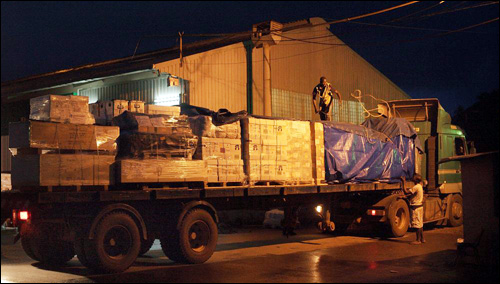The British Red Cross has begun piloting a radio frequency identification system at its Bristol warehouse and London headquarters, in order to identify equipment used during emergency-response scenarios around the world. Approximately 500 assets, such as laptops, satellite telephones, forklifts, vehicles and generators, are being fitted with passive ultrahigh-frequency (UHF) RFID tags that will be read via handheld readers as the items are sent into the field for use by Red Cross volunteers, and again when they are returned. If the British Red Cross determines that the technology works effectively, the agency plans, by January 2014, to begin deploying the technology for field use by local supervisors, at emergency sites worldwide. The organization expects to apply tags to about 5,000 assets at that time.
The system, provided by AIDC Solutions is intended to enable the agency to better manage its assets as they move across the globe in the care of a fleet of volunteers, according to David Myers, AIDC’s operations director.

The International Federation of Red Cross and Red Crescent Societies (IFRC) maintains branches within 187 countries that respond to crises around the world. Those branches send volunteers to emergency sites—often working in an internationally coordinated effort to provide humanitarian aid—and then support those communities throughout their recovery. At the British Red Cross (as with other IFRC branches), volunteers and technical teams are typically sent to the site with Red Cross equipment, such as laptops and satellite phones. When a volunteer’s service has finished, he or she returns those assets to a field supervisor, so they can be stored onsite and then reassigned to the next volunteer. This system can lead to confusion regarding where equipment is located and who has it at any given time, however, especially as the complexity of deployments grows, explains David Northfield, the British Red Cross’ logistic support officer.
The amount of equipment sent to emergency sites is increasing, Northfield reports. At present, sites can require not only mobile phones, laptops or construction equipment, but also sophisticated measurement devices or movie projectors—all of which must be accounted for as the volunteers come and go from emergency projects. “We need to be prepared to account for those assets,” he states, “to provide accountability to our donors.”
The British Red Cross intends to gain visibility into where specific equipment is located, as well as who is responsible for those assets and when an item is being underutilized (based on it remaining in the local warehouse for an extensive period of time). The solution will include Omni-ID UHF RFID tags affixed to assets, handheld readers deployed at emergency sites, and TransitionWorks software running on the British Red Cross’ own server to remotely identify who has which equipment at sites throughout the world.
At the London office, where the organization stores smaller items, individual emergency kits are loaded with such assets as phones and laptops, some of which are now being tagged with Omni-ID’s Flex LP metal-mount UHF tags. The tag’s unique ID number is linked to a description of the asset to which it is attached, along with its serial number, in the TransitionWorks software. The tag can also be encoded with other data, such as a description of the asset and to whom that object is assigned. If the kit is allocated to a crisis location, the staff at the London office can first read the tag using a Psion Teklogix handheld reader, and then input details such as who is taking the kit, and where. All of this data is then stored in the software, as well as written to the tag.
Initially during the pilot, Northfield says, the RFID readers will be used only at the London office, not in the field. The preliminary objective, he notes, is to ensure that the tags are robust enough to be readable following multiple journeys to various parts of the world, after the equipment is used and returned to the office.
At the Bristol warehouse, the British Red Cross stores larger items, such as construction equipment and vehicles. Here, tags are also being applied to these objects, with the intention of determining the best location for tags to be affixed to various assets, as well as the tag’s durability as the equipment or vehicles are moved and operated. Northfield says they are not likely to be interrogated and sent into the field, however, until such a time as a crisis necessitates the use of those assets.
Once the RFID system is fully deployed, a field supervisor would be equipped with a handheld reader, and could allocate assets to volunteers from a warehouse temporarily set up onsite. As a volunteer leaves the site at the end of her service, she would turn in the asset to the field supervisor, who would read the tag via the handheld and reassign that item to the warehouse. Once another volunteer receives the asset, that data would again be updated in the system, based on an RFID read of the label.
The information would be updated on the British Red Cross’ server, enabling management in England to monitor such details as when there is a shortage of a specific asset at a particular site, and to easily locate another site in the area that might have such items that have not already been assigned to a volunteer. Writing data to the tag would enable individuals in the field to then read that tag and view such details as who is responsible for that asset and where it belongs.
In addition, the system will enable the British Red Cross to place the handheld in Geiger counter mode, thereby allowing volunteers to walk through an area or warehouse in order to seek a specific item or perform an inventory check. Personnel onsite at a crisis location could also attach tags to new assets and commission those tags as needed.

